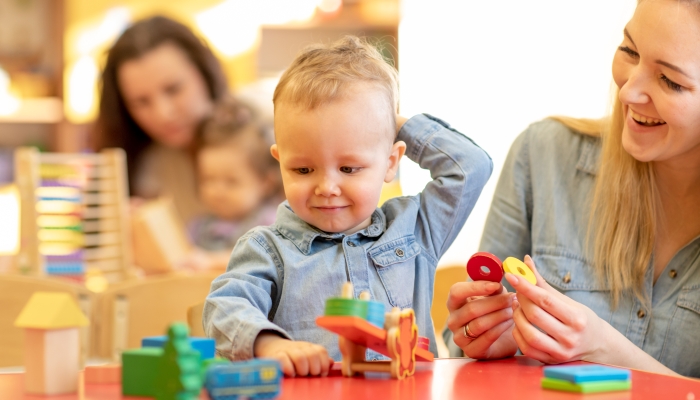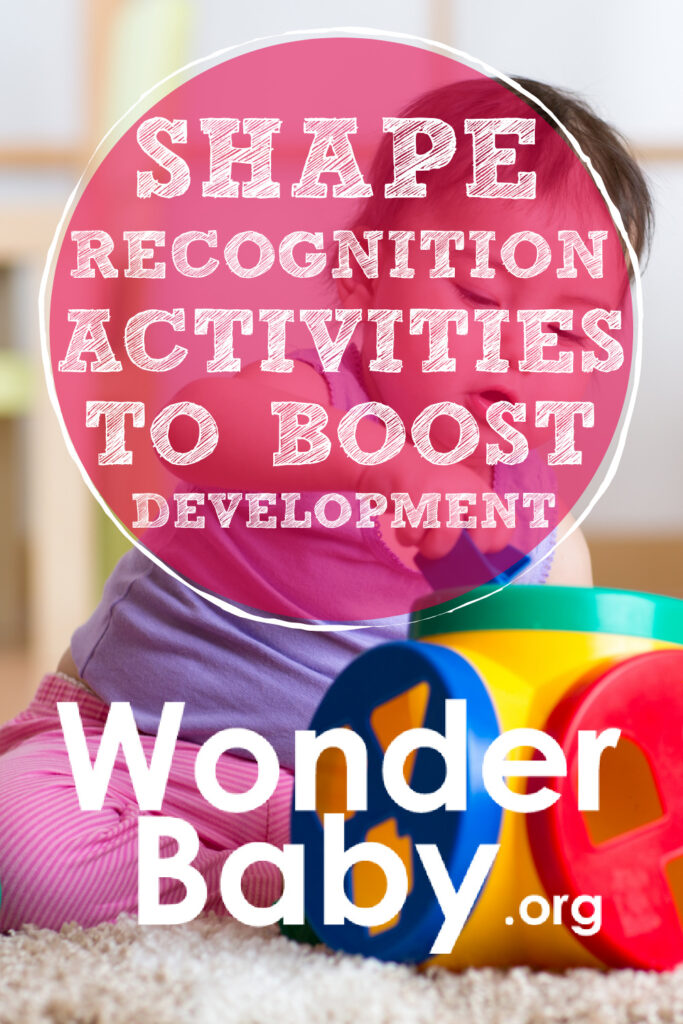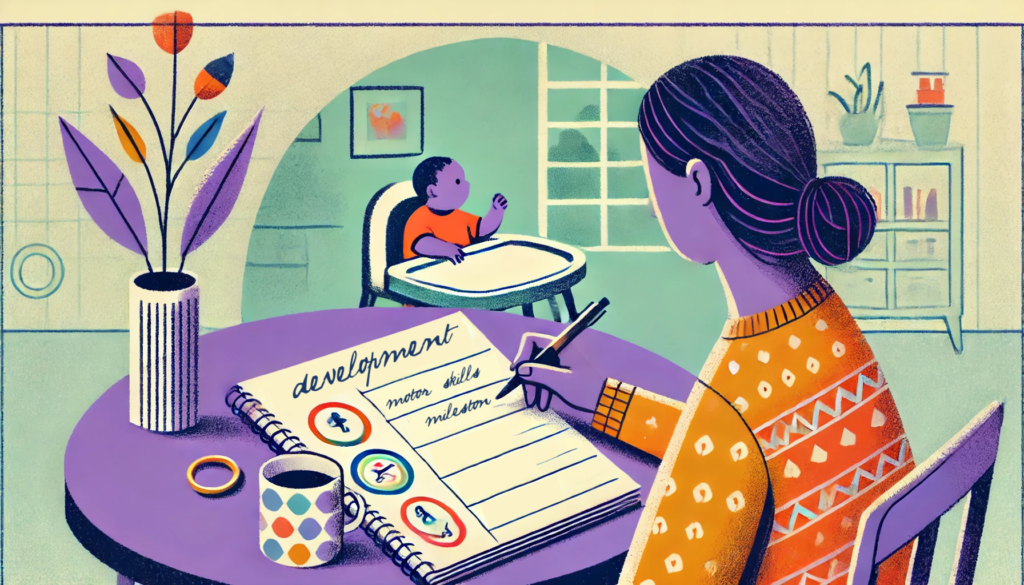5 Shape Recognition Activities to Boost Development

- Children start showing an interest in shapes around 2 or 3 years old, but you can teach your little one about them from birth through everyday interactions.
- Your child can improve their visual-spatial abilities and spatial awareness by recognizing shapes.
- Shapes are a key component of the foundation kids need in math and science.
- There are several ways to help your child learn shapes. Some examples are pointing out shapes, using technology, and playing shape-recognition games.
I started teaching our daughter about different shapes before she went to preschool. When her first report card came home, I could see the games we played and the songs we sang worked! Now, I’m doing the same with our son. Teaching kids about shapes in a fun and interactive way helps them retain what they learn.
Play is learning, and there’s no better way to teach your kids about shapes. Once you understand the importance of shape recognition, you can find out how to play your way through all the shapes!
Shape Recognition: Why Kids Need to Learn Shapes
Recognizing shapes is an essential skill for children. It forms the foundation for many other areas of learning, like math, reading, and science. Here are some reasons why kids need to learn shapes:
Visual-Spatial Abilities: The ability to recognize and manipulate shapes is closely tied to visual-spatial skills. These abilities are important for reading maps, building blocks, and using technology.
Spatial Awareness: Understanding shapes and their properties will help your child develop a sense of how objects relate to one another in specific spaces. This awareness will help them visualize and manipulate objects in their head.
Problem-Solving: Recognizing and identifying shapes will help your little one approach problem-solving and reasoning in a structured manner.
Enhancing Creativity: Recognizing and using shapes can also help your children’s creativity. They can use shapes to create pictures, designs, and other works of art.
Mathematical Skills: Shapes are a crucial component of geometry. Learning about shapes will lay the foundation your kids need for future math skills.

When Is the Best Time to Teach Your Child About Shapes?
Children typically show an interest in shapes around 2 or 3 years old. This is a great time to teach them more about it. Preschoolers should identify and recognize basic shapes.
You should, however, teach shape recognition before this age. Children can start learning shapes in a fun and playful way from birth! You can point out shapes in their environment and identify them in their toys.
You can also use everyday objects to show your child how different shapes look. Talking to your kids about shapes will help develop their awareness of them.
You don’t need worksheets and complicated activities to help your children learn shapes. Dr. Kate Green (Ph.D. in Child Development) says that learning through play positively influences literacy and mathematic development in children.
At What Age Should a Child Be Able to Identify Basic Shapes?
Every child develops at their own pace. Don’t be concerned if your kid takes a little longer to grasp the concept of shapes. Most children will identify basic shapes like circles, squares, and triangles by age 3 or 4.
Your child will likely hit this milestone on time if you playfully introduce shapes. Kids should be interested and motivated to learn about shapes if you want them to retain the information. Hands-on activities and games will capture their attention and help them enjoy getting to know different forms.
How to Help Your Child Learn Shapes
Preschool teachers often focus on shapes before teaching kids the alphabet. This is because forms build the knowledge children need to learn letters and how to read. You can help your child learn shapes long before they go to school. Below are some fun ways to do this!
Help Your Child Learn Shapes by Using Real-Life Examples
The easiest way to teach shape recognition is by pointing out shapes in your child’s surroundings. This will help your child make real-world connections and reinforce their understanding of different shapes.
You can point out square windows, round wheels, or the triangular shape of a pizza slice. Ask your little one to look for and identify different shapes as you do your daily activities. You can make a game out of it or challenge them by asking for a specific shape.
If you have more than one child, motivating them with a prize is also a good idea!
Help Your Child Learn Shapes by Playing With Them
Playing with shapes is a fun and interactive way to learn. Give your child different types of shapes to play with. You can encourage older children to build structures with blocks and identify the shapes they use. Shape sorting toys and toddler puzzles are great for toddlers starting to learn shape recognition.
If you have play dough, press out a few shapes with your cookie cutters and ask your kids to match them. You can also draw, color and paint different shapes.
Help Your Child Learn Shapes by Using Technology
There are many educational apps and games available that help children learn shapes. Look for age-appropriate content that is fun and interactive.
You can find games that teach shape recognition, sorting, and matching. Some games develop problem-solving skills and teach children how to draw shapes. For younger children, choose games with common shapes like the circle, the square, the triangle, and the rectangle. Preschoolers should play games introducing the oval, star, diamond, and heart.
Note: Read feedback from other parents and limit screen time.

5 Shape Recognition Activities Kids Will Enjoy
You can do many activities with your children at home or on the go to teach them shapes. Below is a list of games you can play that will teach shape recognition while encouraging creativity, problem-solving, and practicing gross, fine, and visual motor skills.
Shape Scavenger Hunt
You can create a shape-inspired scavenger hunt where your child has to find and identify shapes in your house or at the park. This activity will help little ones make real-world connections, practice problem-solving skills, and reinforce shape recognition.
Here’s a simple guideline for this activity:
- Make a list of all the shapes your children need to find. You can also give them shape cards that they have to match to real-world objects.
- Set a timer to add a sense of urgency and get your kids excited!
- Reward the winner with a small prize. If you only have one child, motivate them with their favorite treat or another activity once they complete the scavenger hunt.
Shape Sticker Designs
Playing with stickers is a fantastic fine motor activity that’s easy to set up. Children can come up with great ideas when doing this task!
Start by giving them stickers made from different shapes and pieces of paper. You can ask your child to create an image using stickers to represent different objects. They can use a circle for the sun or triangles for trees. Let them be creative and explain to you how their imaginary picture was made when they’re done.
This activity encourages creativity and helps kids identify how shapes can be used to represent different objects.
Shape Bingo
If you want to teach shapes to preschoolers, playing shape bingo is a fun way to do this. This game will help children recognize shapes, practice matching, and build their visual and fine motor skills.
To prepare for this activity, create a worksheet with shapes or objects representing shapes. Use colors and pictures that will grab your child’s attention.
Give your child the bingo sheet and ask them to place a sticker or other marker on the shapes when you call them out. You can show your kid pictures of shapes, say their names, or point to real-world objects.
Sing Shape Songs
Singing shape songs is a lively and entertaining way to help children learn about and recognize shapes. This type of activity is especially beneficial for younger kids. Songs help kids engage their imagination and improve their vocabulary.
Singing shape songs is one of the best ways to teach shapes. Your child will develop memory skills when they repeat information, like the names of shapes. Shape songs also expand vocabulary by introducing new words and concepts.
Many shape songs involve movements and gestures. Making this fun will help your child stay engaged and excited to learn the words.
You can choose between great shape songs like:
- Shape Are All Around by Pinkfong Songs
- The Shapes Song by Oh My Genius
- Nashville Shapes Hoedown by Busy Beavers
- Shape Song by CoComelon
- Sing Along Shape Song by Bounce Patrol
- Shape Song by Gracie’s Corner
Shape Sorting
Shape sorting games provide a fun way to practice shape recognition and fine motor skills. It also contributes to cognitive development and improves problem-solving abilities. You can get creative when setting up a shape-sorting game. Here’s an easy-to-create game that you can adjust to your kid’s age:
- Give your child a basket containing different-shaped objects like wooden blocks, puzzle pieces, or cut-outs.
- Ask them to sort the shapes into categories like circles, squares, and triangles.
- Make the game more challenging by asking them to color-sort the shapes too!
This activity will practice categorizing and grouping while reinforcing their understanding of different shapes.
The Secret to Learning Shapes: Play!
You don’t even have to look closely to figure out that rectangles, circles, squares, and triangles are around us all day. Kids who know the difference between these shapes can identify and organize visual information. This is one of the biggest reasons to start learning shapes early on.
If you keep the activities you do around shape learning playful, I’m sure your kids will stay engaged and retain information. Remember to choose age-appropriate games and adjust your expectations for your child’s abilities.

Related Posts

Development, Special Needs
How to Track Milestones for Developmentally Delayed Babies
Parents of developmentally delayed babies can explore practical tools and strategies to track milestones, celebrate progress, and support their child’s unique developmental journey.

Fine and Gross Motor
5 Alternatives to Tummy Time for Babies with Motor Development Challenges
Does your baby struggle with tummy time due to motor development challenges? These alternatives to tummy time will offer the same benefits.

Development
Should Twins Share a Room?
Wondering if your twins should share a room? We’ll explore the pros and cons of room-sharing for twins right here before you make your decision.